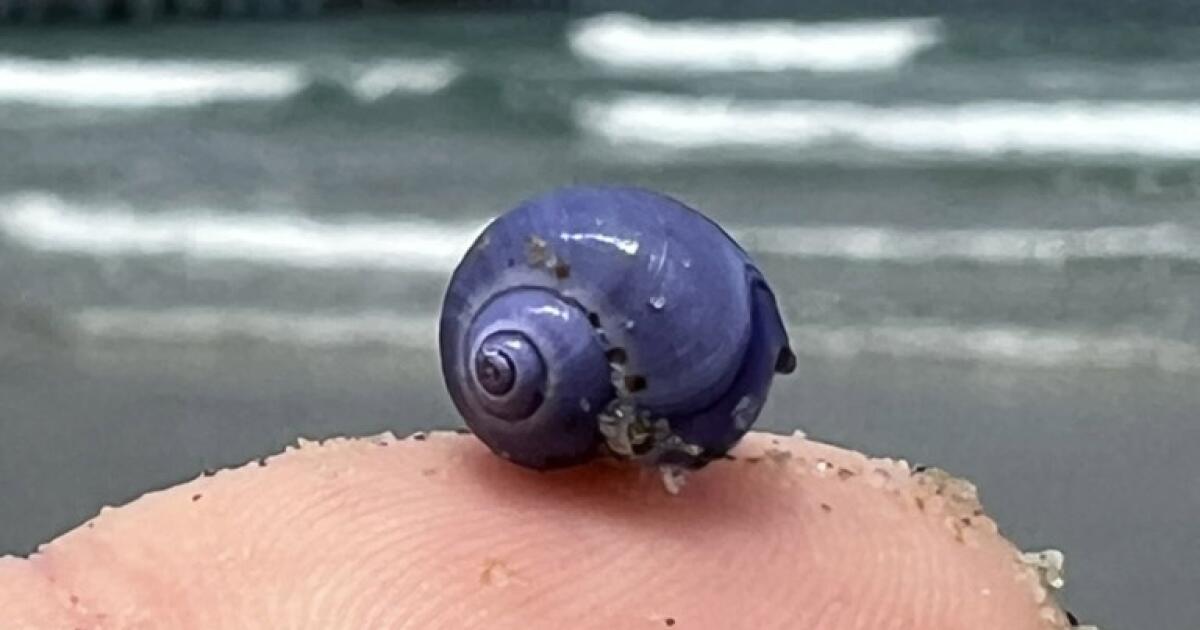Oceanographer Anya Stajner was recently enjoying a sunset walk along the La Jolla Shores beach when a vibrant violet pop of color caught her eye in the sand.
She got down on her hands and knees and was astonished to realize she had stumbled upon a rare species of sea snail, Janthina janthina.
These creatures, more commonly known as violet snails, are distinguished by their striking purple shell and the delicate bubble raft they secrete to stay afloat in the open ocean. They are not known for their presence on Southern California beaches.
“When I saw it on the beach, I instantly knew what it was, but I was in complete shock,” said Stajner, a fifth-year doctoral student at the Scripps Institution of Oceanography at UC San Diego. “I would never expect to see one washed up in San Diego. The odds of that are so slim.”
The violet snails are known for their vibrant hue and their ability to float at the surface of the ocean thanks to the bubble rafts they create.
(Anya Stajner.)
J. janthina are a pelagic snail species, meaning the creatures spend their lives at the surface of the ocean as opposed to in tide pools or along the ocean shore. Their bright violet color is believed to be a form of UV protection to shield them from the harsh rays of the sun.
Stajner’s discovery marks the first time that Scripps researchers have spotted these violet snails on local beaches in a decade, she said.
J. janthina are typically found in toasty subtropical to tropical seas. Their sparse sightings along the Southern California coast often coincide with warmer offshore waters flowing toward the shore.
“The day that I found my specimens, the water was notably warm,” she said. “I remember when it washed up on my feet, I was like, ‘Whoa, this is hot.’”

Janthina janthina secrete a bubble raft that enables them to stay afloat at the ocean’s surface.
(Anya Stajner)
Stajner can’t say for certain whether her discovery is connected to climate change but noted that this is a question researchers will want to examine in the future.
“I think it’s something that we will be on the lookout for,” she said. “If these warm waters continue, we will want to see if we have any more of these violet snails washing ashore.”
If any beachgoers spot J. janthina in Southern California, Stajner urges them to take photos and send them to Scripps. However, she reminded people that certain beaches, such as La Jolla Shores, are designated “no take areas,” where the public is not allowed to remove living creatures.
In total, she collected about 10 snails and brought them to the university’s Pelagic Invertebrate Collection to examine.
Under the microscope, she was able to see the thousands of eggs collected in red sacks inside one of the shells. She also got an up-close look at the delicate purple whorls on the exterior of the snails’ shells.

Under a microscope, egg sacks are visible inside one of the sea snails found in the sand at La Jolla Shores.
(Anya Stajner)
J. janthina typically will have a darker violet hue on the top of their shell to make them blend in from a bird’s-eye view, Stajner said. Their underside is often a lighter lavender to make them harder for sea predators to spot from below as they glimmer along with the sun on the ocean’s surface.
These sea snails are also voracious predators themselves and feast upon free-floating hydrozoans such as Velella velella and Portuguese man o’ war. “They’re small, but they’re mighty,” she said.
Stajner said she is thrilled by the public attention her discovery has received and hopes it inspires more people to go explore the diverse aquatic life present along Southern California’s shores.
This story originally appeared on LA Times

